
















Proactive business strategies during COVID-19 supported
4,797
AT

$229,186,269
29 PROGRAMMING FOR RESEARCH, EDUCATION, AND OUTREACH
ENDOWNMENTS TO HELP STONE LAB’S































Proactive business strategies during COVID-19 supported
4,797
AT

$229,186,269
29 PROGRAMMING FOR RESEARCH, EDUCATION, AND OUTREACH
ENDOWNMENTS TO HELP STONE LAB’S













Lake Erie is a vital resource to Ohio, supplying drinking water, recreational opportunities and employment to millions of people. The lake is weathering its fair share of problems, from harmful algal blooms to industrial pollution, but it also faces new potential threats to its health. One of those threats is quickly gaining more attention from scientists, and it’s also one that residents can play a large role in addressing: contamination from pharmaceutical products.
Pharmaceuticals and personal care products (PPCPs) are a collection of compounds used for medical or cosmetic purposes: everything from antibiotics and antidepressants to sunscreen and insect repellants can be included in this designation. PPCPs are considered contaminants of emerging concern, meaning their impacts on an aquatic ecosystem and its residents aren’t well studied, but early research suggests that a closer look is warranted.
Dr. Xiaozhen (Jen) Mou, associate professor of biological sciences at Kent State University, is one of the scientists working on PPCP contamination in Lake Erie waters. Together with Dr. Laura Leff, professor and chair of biological sciences at Kent State, Mou is investigating the occurrence of PPCPs in water sources and treated waters in four northeast Ohio water treatment plants.
“There’s not a lot of research on the long-term impacts of the PPCP compounds at very low concentrations,” said Mou. “We know those pharmaceutical compounds are treating diseases at pretty high concentrations, but hundreds of different compounds are all together in this pool, and we don’t know how they interact with each other.”
An additional concern is about chronic exposure to small doses of a wide range of compounds over a long period of time. “In small animals and invertebrates we do see some impacts even at very low concentrations, where some of the animals might develop tumors or behavior problems, so there’s the potential that these compounds can be a problem for humans or wildlife,” Mou explained.
For now, Mou’s work focuses on establishing a baseline of eleven common pharmaceutical and personal care compounds – mostly antibiotics, anti-seizure medications, anti-inflammatories, insect repellants and hormones such as those used in birth control – found in both source and treated waters from drinking water treatment plants.

Samples from four northeast Ohio water treatment plants show that current water treatment protocols remove a large percentage of the

studied pharmaceuticals, but in most cases where a compound was present, some percentage of it remained in finished drinking water.

Mou and her team want to continue this research at more water treatment plants, and they are actively seeking funding to do so. In addition, they are trying to draw connections between antibiotics and the presence of antibiotic resistance genes in bacteria found in the water. If gene expression is connected to the levels of antibiotic contamination, they may be able to develop a relatively simple test to quickly detect very low concentrations of antibiotics in water samples.
“It’s not necessarily that we have to be panicked now, but if we can be proactive, it won’t be a problem for the future,” Mou said. “But if we ignore it and don’t try to figure out whether it’s going to be a real threat, we might feel sorry about that later.”
It’s not necessarily that we have to be panicked now, but if we can be proactive, it won’t be a problem for the future. But if we ignore it and don’t try to figure out whether it’s going to be a real threat, we might feel sorry about that later.”
DR. XIAOZHEN MOUPPCP s MOST COMMONLY INCLUDE:
Prescription & other medications
Personal hygiene products
Antibiotics in northeast Ohio were sampled as part of Mou’s research
To help not just researchers but also the public be more conscious of PPCP contamination, and to advocate for more effective ways to reduce or prevent that contamination, social scientists pick up where the biochemists and microbiologists leave off.
Dr. Victoria Campbell-Arvai, assistant research scientist at the University of Michigan, conducted online surveys and focus groups with people in Ohio’s Lake Erie watershed to gain insight into their PPCP disposal knowledge and habits. She also gathered input on what barriers people face when wanting to dispose of unused medications properly, and how those barriers should best be addressed.
Currently, information about proper disposal of unused medications is hard to find and sometimes even contradictory. While most websites start by suggesting takeback events at pharmacies or secure disposal sites like law enforcement offices, the U.S. FDA recommends flushing medications if takeback events aren’t available. The Ohio EPA, in turn, strongly encourages use of takeback events and advises against flushing.
“So right there you have contradictory messages,” Campbell-Arvai said. “In the FDA’s view, it’s better to flush potentially addictive medications like opioids than to have them fall into the wrong hands. But
Drawing active connections between proper disposal methods and the health of Lake Erie could be one way to develop those same social norms in the U.S. for using proper disposal methods.”
people in the focus groups were also asking why we’re giving this message about flushing if it’s going to end up in the Great Lakes, and you’re just kicking the problem down the road.”
Focus group participants agreed that information about proper medication disposal needed to be presented in clear, simple language, and that having to click through multiple links and web pages to get to the correct information is problematic. They also emphasized that making correct disposal options easy and convenient is essential to getting more people to participate.
While disposal events can be expensive, they’re also the best way to remove unwanted pharmaceuticals from circulation. Holding events more frequently, in more convenient locations and with better advertising would likely go a long way to increase people’s participation in proper disposal practices. Public events and the advertising they require also tend to raise awareness about the problems unwanted medications can cause, so that even if people don’t participate in any one event, they may be more likely to pay attention to, and participate in, future events.
In addition to more frequent takeback events, people in the focus groups also suggested more consistent, simplified messaging around the impacts of improper medication disposal on both human health and the environment. While people are generally aware that flushing medications isn’t a good approach, trash disposal is still common, so messaging that emphasizes the importance of returning unused medications to drop boxes or events was another common suggestion emerging from this project.
To the researcher’s surprise, however, having a favorable attitude toward the use of takeback events wasn’t strongly linked to actual participation in those events.
“In the United States, there’s pretty low behavioral compliance in terms of proper disposal practices, which basically means returning unused medications to a secure drop box or a takeback event,” Campbell-Arvai said. “But in a country like Sweden, 90 percent of citizens either intend to or have returned their unused and unwanted pharmaceuticals to a pharmacy or takeback event. So the potential is there; people will do it if provided the opportunity.”

Federal funding and logistical help from pharma companies in Sweden support holding more takeback events, but CampbellArvai also suspects that a big part of the puzzle are the strong social norms for proper medication disposal. Focusing on the idea that other people in the community are participating in takeback events, and drawing active connections between proper disposal methods and the health of Lake Erie, could be one way to develop those same social norms in the U.S.
“This problem can be solved,” Campbell-Arvai said. “It’s not one of those insurmountable challenges, it’s just about putting in place a system that will make it easy and obvious for people to properly dispose of their unused and unwanted pharmaceuticals.” ●
Scan the QR codes to get more information about how to dispose of expired medications.
This problem can be solved. It’s not one of those insurmountable challenges , it’s just about putting in place a system that will make it easy and obvious for people to properly dispose of their unused and unwanted pharmaceuticals.”LEARN MORE ONLINE U.S. FDA OHIO EPA DR. VICTORIA CAMPBELL-ARVAI
First Published January 6, 2021
Aquaculture is a growing industry in Ohio and the Great Lakes region, providing farm-raised seafood ranging from crawfish to walleye. And just like land-based farms, fish farmers spend a lot of time making sure their animals are healthy. Ohio Sea Grant researchers at Bowling Green State University (BGSU) are helping with that.
Dr. Zhaohui Xu, Associate Professor in the Department of Biological Sciences at BGSU, recently provided a baseline of bacterial populations in fish farm ponds that can be used as a reference for future studies. Ohio fish farmers often use commercial probiotics in their aquaculture ponds, but little independent research has been done to determine whether these probiotics actually affect water quality and microbe communities in a meaningful way.
To help future research projects make that determination, the research team monitored water quality at an Ohio sunfish farm over several weeks, and also performed DNA testing on microbial communities drawn from water samples. They found that communities differed quite a lot between ponds on the same farm, between samples taken from the edges of a pond and the center, and with water temperature, regardless of whether they had been treated with probiotics or not.
“Somehow even in those ponds on the same farm, you see that their water and their microbes are very different from each other,” Xu said. “We also interviewed the owner about the history of the ponds, and we suspect the management of the ponds is the biggest contributor of those differences.”
About half of the bacteria found in the samples were not yet identified. “The scientific community estimates that we only know less than one percent [of bacteria in the world],” Xu explained. “Even though microbiology has been established as a discipline for several centuries, we still just know a very tiny fraction about the microbes out there. We know they exist, based on DNA and what we see under a microscope, but we don’t always know who they are or what they do.”

While most of those unknown microbes will likely turn out to be harmless, some of the ones researchers already know about can cause diseases, including in fish that are raised in aquaculture operations.
Dr. Vipa Phuntumart, Associate Professor in BGSU’s Department of Biological Sciences, along with collaborators at The Conservation Fund’s Freshwater Institute in West Virginia and at the USDA Agricultural Research Service’s National Aquaculture
Research Center in Arkansas, have developed a method to detect a fish disease caused by Saprolegnia species, a fungallike pathogen that result in an estimated loss of $40 million to U.S. aquaculture operations.
“Saprolegnia is usually not very serious in aquaculture operations,” Phuntumart said. “However, if the fish are stressed by a rapid change in water temperature, they become immunocompromised and susceptible to these pathogens.” Another potential cause for a decreased immune response is vaccination to protect the fish from viral infections.
By detecting the pathogen in the water before fish show symptoms, aquaculture operations can begin treatment earlier. So the research team developed an assay that combines various molecular testing methods to quantify Saprolegnia in water samples from recirculating aquaculture systems (RAS) that were provided by the Freshwater Institute.
Two molecular assays, loopmediated isothermal amplification (LAMP) and quantitative polymerase chain reaction (qPCR), were developed to detect the presence of the pathogen in the aquaculture operation, letting fish managers know when to treat the water.
“When people are being treated with HIV drugs, they take a blood sample and they monitor how good the drug is by looking at how much virus is present in the patient sample. So we use the same strategy when they send us a water sample,” Phuntumart explained. “From that sample, we can calculate how much pathogen is present in the larger volume of water, and if it is above
the threshold, we would recommend water treatment.”
Treatments include eco-friendly options like hydrogen peroxide or peracetic acid, which break down into non-toxic molecules like water and oxygen.
The researchers expect the same detection method to also work for other pathogens, from fish to plants to humans. In fact, the detection system Phuntumart and her team developed for Saprolegnia includes a dye component that is now being used in a COVID-19 testing kit.
“One of my PhD graduates is now working at a company, using the techniques he learned here, to develop a test for COVID-19,” Phuntumart said, rightfully beaming with pride. That’s the kind of interdisciplinary application of research that any scientist would be proud of. ●
Ohio Sea Grant has funded seven new research projects totaling over $970,000 as part of the 2022–2024 research grants program. The projects, located at universities across Ohio, cover topics ranging from climate change resilience and aquaculture to microplastics concerns and harmful algal bloom toxins, to help solve critical issues affecting the state’s environment and economy.
> An Integrated Framework to Quantify and Improve the Climate Change Resiliency of Stormwater Systems in Northeast Ohio — University of Cincinnati; Virginia Tech
> Community Engagement in Coastal Ohio for the Resiliency of Storm Drainage Infrastructure Against Climate Change — Youngstown State University; Chagrin River Watershed Partners
> CRISPR—Based Portable Biosensor System for On—Site Detection of Fish Pathogens — Bowling Green State University
> Lake Erie Oxygen Dynamics Across the Normoxia to Hypoxia Transition Zone off the Cleveland Coast — Cleveland State University
> Microplastic Removal During Drinking Water Treatment — The Ohio State University
> Spatial Ecology of Smallmouth Bass in Lake Erie — Ohio Division of Wildlife, Sandusky Fisheries Research Station; Great Lakes Fishery Commission
> Stoichiometry Meets Genomics: Assessing Limiting Factors for Diverse CHABs and Their Associated Toxins — Large Lakes Observatory, University of Minnesota Duluth; University of Wisconsin— Milwaukee; Bowling Green State University
Learn more about Ohio Sea Grant funding opportunities at ohioseagrant.osu.edu/research/funding
SEVEN NEW RESEARCH PROJECTS HAVE BEEN FUNDED TOTALING OVER

$970,000
as part of the Ohio Sea Grant 2022–2024 research grants program
Even though microbiology has been established as a discipline for several centuries, we still just know a very tiny fraction about the microbes out there.”
DR. ZHAOHUI XUSAPROLEGNIA under a microscope
Veterinary antibiotics are commonly used in livestock operations, and up to 90% of those antibiotics can be excreted by livestock unmetabolized. Dr. Laura Johnson at Heidelberg University is examining whether antibiotic concentrations in water samples can be linked to variation in nutrient runoff from livestock farms into Lake Erie.
> Dr. Christopher Spiese | Ohio Northern University
Different chemical forms of phosphorus have different impacts on algae and bacteria in an ecosystem like Lake Erie, but most methods can’t distinguish them in water quality analyses. Dr. Christopher Spiese at Ohio Northern University is using methods from oceanography and lake studies to develop methods to distinguish these chemical forms of phosphorus in water quality testing.
Rainfall in urban areas can contribute to water pollution and flooding, based on how grey infrastructure like sewers and green infrastructure like retention ponds influence water flow. Dr. Kevin Mueller at Cleveland State University has quantified water flow through the canopy of 12 tree species to help urban forest managers better select trees for stormwater management.
Dr. Anne Jefferson at Kent State University is establishing plastic debris hotspots in a Cleveland watershed that could be targeted for more effective cleanup efforts. Microplastics concentrations in one study beach are almost 20 times higher than previously reported, suggesting a need to improve plastic debris management efforts.

Dr. Silvia Newell at Wright State University is developing a recirculating aquaculture system for perch production that uses excess nitrogen from the fish’s waste products to grow prawns and tomatoes. The team was able to keep nitrogen below dangerous levels in their model system, and presented the system to interested fish farmers this summer.
Dr. Kennedy Doro at The University of Toledo is using imaging techniques like ground-penetrating radar, electromagnetic imaging and electrical resistivity to map current and future wetlands in an effort to better manage restoration and nutrient runoff in these areas around Lake Erie. The team also mapped variations in soil conductivity in three study sites, which can be used to improve sampling plans as part of a larger H2Ohio/ LEARN/Ohio Department of Natural Resources initiative.
Phosphorus from the Maumee River watershed is the primary driver of harmful algal bloom size in western Lake Erie. However, there is limited information about the role of rivers in shaping phosphorus loading to the lake. Dr. Jim Hood at The Ohio State University is developing a new model to characterize how phosphorus moves through agricultural streams in the watershed to determine how phosphorus runoff changes throughout the year.
Learn more about Ohio Sea Grant research and funding at ohioseagrant.osu.edu/research
 By Christina Dierkes | First Published November 15, 2021
By Christina Dierkes | First Published November 15, 2021
Stone Lab’s Lake Erie Science Field Trips have been a staple of the lab’s school-year programming for over thirty years, giving students in grades 5-12 the chance to become Lake Erie scientists for a day, participate in ongoing research, and become more familiar with Ohio’s Great Lakes coast. But sometimes, traveling to Gibraltar Island isn’t an option, whether that’s because of distance, cost, or other reasons.
To help address this concern, Ohio Sea Grant and Stone Lab have released the first two in a series of virtual field trip experiences for students in grades 5-12. Information is available at go.osu.edu/SLvirtual, along with links to purchase lesson sets through The Ohio State University’s ScarletCanvas platform. Individual field trips are priced at $50 and coach teachers through providing a virtual Stone Lab experience for their students.
Each field trip includes a video from the field, along with teacher materials, student worksheets and presentation slides, making it easy to integrate the materials into the classroom. Teachers can also schedule a Chat with A Biologist session after they complete the field trip, giving their students the chance to meet real-life working scientists who study the topics covered in the lesson.
“We wanted to offer teachers and students a chance to still have a version of the Stone Lab field trip experience when travel to the lab isn’t possible for them,” said Dr. Brian Alford, Stone Lab assistant director. “We also hope the lessons will help enhance learning for our field trip groups, either to prepare them for their visit or to review what they learned once they’re back in the classroom.”
Stay tuned to social media and the Ohio Sea Grant email newsletter for announcements as additional virtual field trips are completed. Newsletter sign-up and links to social media channels are available at go.osu.edu/subscribe
The Fish Identification lesson introduces students to information about Lake Erie fish and how to identify them. The set includes video from a Stone Lab fish trawl along with teacher materials, student worksheets and classroom presentations. The accompanying Chat with A Biologist session can be scheduled with Alford, fisheries Extension educator Tory Gabriel, or Stone Lab manager Kevin Hart.
The Benthic Macroinvertebrates field trip focuses on collecting common benthic macroinvertebrates and using them to determine the health of aquatic ecosystems. The set includes video showing collection techniques in a stream, along with teacher materials and worksheets that allow students to estimate the health of an ecosystem. The accompanying Chat with A Biologist session can be scheduled with Alford, Hart, or Ohio Sea Grant Associate Director Dr. Kristen Fussell.
In addition to connecting directly to Stone Lab’s Field Trip Experiences, each lesson has been carefully aligned to the Next Generation Science Standards, the Ohio Learning Standards for Science and the Model Science Curriculum, and the Great Lakes Literacy Principles, according to education specialist Angela Greene, who co-wrote the lessons.
Teachers who complete each module with their students will also receive a certificate for five professional development contact hours.
Other planned topics for virtual field trip lessons include herpetology and limnology. Herpetology is the study of reptiles and amphibians such as snakes and frogs, and limnology covers topics like water chemistry and the biology of lakes, including plankton communities. ●
Led by Ohio Sea Grant and the Ottawa County Improvement Corporation, representatives from Ohio Sea Grant and Illinois-Indiana Sea Grant met with county, city, and state agency officials in Ottawa County to conduct the Tipping Point Land Use Planner Program in April 2022. Sessions included community visioning, a current understanding of the local ecosystem and Lake Erie’s current conditions, education on innovative land management strategies, and coaching for action plans.
The goal of the program was to generate information for use in updating Ottawa County’s comprehensive land use plan. Through facilitated tools and discussion, the planning team helped local officials and residents determine the impacts of land use decisions and prioritize best management practices that balance the impact of development decisions with concern for the environment.
“The Tipping Point Planner Program guides community groups, boards, and commissions through facilitated action planning sessions to support locally driven natural resource management strategies and policy,” said Ohio Sea Grant Extension educator Joe Lucente, who helped facilitate the sessions.
Community groups participating in the program were also able to identify issues of concern to Ottawa County residents and bring up program topics for land use planning at a watershed scale.

The result of the program is a county-wide action plan, along with strategies for implementation projects that can be used with watershed plans, comprehensive plan updates, or plan commission recommendations. ●
Freshwater Science webinars present Ohio Sea Grant research and other projects from universities across Ohio to the science-interested public in easyto-access half-hour presentations. The 2022 series included topics ranging from harmful algal bloom toxins and fisheries to community development and pollution prevention.
The Tipping Point Planner Program guides community groups, boards, and commissions through facilitated action planning sessions to support locally driven natural resource management strategies and policy.”
JOE LUCENTE
To host a planner program in your area, contact Lucente at lucente.6@osu.edu.
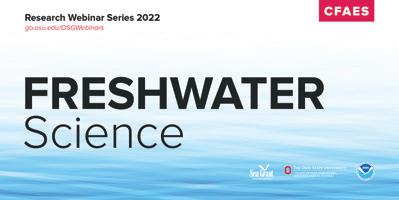


 By Jill Jentes Banicki
By Jill Jentes Banicki
Great Lakes lighthouses have always sparked our curiosity. Known as beacons of light that provide safe passage for ships, they also attract visitors with their individual stories and maritime history. One of these famous lighthouses is the South Bass Island Lighthouse, owned by The Ohio State University and managed by Ohio Sea Grant and Stone Laboratory. Thanks to a National Maritime Heritage Program grant administered by the National Park Service (NPS) and the Ohio History Connection, Put-in-Bay visitors can now learn all about the South Bass Island Lighthouse’s history through six new educational displays located around the lighthouse grounds.
“Lighthouses have been such an important piece of the Lake Erie islands’ history and we realized we could do our part to help educate visitors who come to our South Bass Island Lighthouse,” said Dr. Kristen Fussell, Associate Director of Ohio Sea Grant and Stone Lab. “This NPS grant gave us the opportunity to do that.”
Five of the educational displays provide visitors with an overview of the grounds, information about the Lake Erie passage, the lighthouse’s unique red brick architecture, the 10-sided Fresnel lens that illuminated its coastline, and the lighthouse’s 10 keepers who helped ships along their way.
The last display focuses on Green Island, which is visible from the South Bass Island Lighthouse grounds. Now a wildlife refuge for Ohio Division of Wildlife and no longer accessible to the public, the display showcases the lighthouses that used to be at Green Island before fire left only their remnants. ●
The South Bass Island Lighthouse grounds are open to the public for free from dawn to dusk in the summer. For information about the lighthouse and its summer guided tours, visit go.osu.edu/lighthouse
In the early 1900s, mail and freight to South Bass Island were brought across the ice and open water by ironclad boats. Passengers paid up to $5 for the privilege to help push the boat across, and keeper families sometimes helped them come ashore.

Keep up with current classes, research and events on social media.
ONLY AT STONE LAB CAN YOU…
“…get the opportunity to work with water quality equipment!”

ALEX KUSHNIR, SEMESTER AT STONE LAB STUDENT, OHIO STATE SENIOR ENVIRONMENTAL SCIENCE MAJOR
“…conquer your fear of catching snakes!”
LEXIE SHISHOFF, RECENT OHIO STATE GRADUATE IN BIOLOGY AND EVOLUTION, ECOLOGY, & ORGANISMAL BIOLOGY
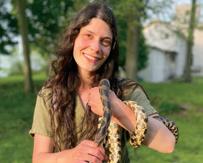
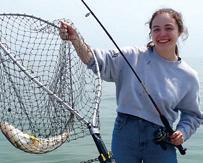
“…catch a fish for the very first time!”
SCHUYLER BUTZE, SEMESTER AT STONE LAB STUDENT, OHIO STATE SENIOR ENVIRONMENTAL SCIENCE MAJOR

“Name a more beautiful place to live and work than @stonelab and @visitputinbay. It is a wildlife biologist’s dream! Every day was a new day to explore #herpetology, #ornithology, #limnology, #entomology, and of course #ichthyology.”

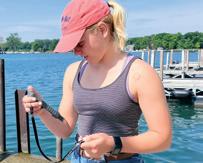
Read more stories on our Facebook and Twitter pages.
Stone Lab’s Biological Field Station Assistant
Stone Lab is more than just a place for classes. It’s a place to make friendships, memories, and learn to appreciate the beauty of our Great Lakes.”
JO WESTER, OHIO STATE SENIOR ENVIRONMENTAL SCIENCE MAJOR











illions of pounds of plastic pollution make their way onto the beaches of the Great Lakes region each year, and plastic bags have rocketed onto the list of the top ten items found on beach cleanups over the last couple of decades. Plastic in the waterways poses serious threats to human safety, and plastic bags are a major contributor to the problem.
Jill Bartolotta and Scott Hardy—extension educators with Ohio Sea Grant—have been hard at work gathering information about what methods will help the most when encouraging people to reduce their plastic use. After everything from supplying people with reusable bags, to handing out promotional keychains, to collecting over 1,200 surveys, the evidence was clear: people want to reduce their plastic waste in theory, but in practice they make mistakes like forgetting their bags in the trunk of their car, and instead use the convenient, free bags at the store. Out of 1,600 reusable bags given to the public at Lake County farmers markets during Hardy and Bartolotta’s studies, only 188 were seen at the markets after they were handed out.
“If a local government has money set aside for green issues, in this case reducing plastic pollution, spending it to buy more reusable bags is not an effective use of resources,” Hardy said. “Our studies suggest that we already have bags, you can get reusable bags anywhere, we just forget them. That encouraged us to look elsewhere to take next steps. We wondered how to get people to remember their darn bags, and what alternatives exist.”
Instead of handing out bags or supporting the purchase of reusable bags, Hardy and Bartolotta try to motivate the public to bring boxes from home, use produce boxes from the store, or simply carry a few items.
“The cost of creating reusable bags in terms of natural resources and fossil fuels is astronomical, really,” said Bartolotta. “We’re trying to encourage people to bring whatever they have from home.”

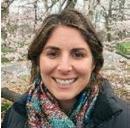
 SCOTT HARDY Hardy.116@osu.edu
SCOTT HARDY Hardy.116@osu.edu
Bartolotta and Hardy collected
1,200 SURVEYS AS PART OF THEIR RESEARCH
Out of 1,600 reusable bags given to the public at Lake County farmers markets, only WERE SEEN BEING USED AT THE MARKETS IN THE FUTURE
188
he entire public is not going to change their behavior overnight. Bartolotta and Hardy have used many methods of helping people to remember their bags in their studies, from reusable containers to magnets to window decals. The challenge of reaching as many people as possible is only a part of the issue, however. The even more complex side of the problem is being able to reach individual people, on a personal level.
“It’s a very complicated process to explain to someone that using a bag at a store could affect the water quality fifty years from now,” said Bartolotta. “It’s so far removed from their everyday life.”
Bartolotta and Hardy are both personally connected to the Great Lakes; they live in the Cleveland area and have witnessed the rise in plastic garbage polluting the streets and waterways. Bartolotta has been kayaking and paddleboarding on Lake Erie for over fifteen years and has seen the dramatic increase in pollution firsthand.
With their personal experiences influencing their outreach work, Bartolotta and Hardy encourage people to make easy, small changes to their everyday lives, and empower them to have open conversations with their friends and family. Often, separating people by age groups and interests helps the educators to determine their approach.

“We explain the issue and relate the issue to what matters to them, and give them simple solutions,” said Bartolotta. “What matters to a 14- to 20-year-old is not going to be the same as what matters to a 40- to 60-year-old.”
Though educational outreach is vital, it’s only a piece of the puzzle. Bartolotta and Hardy understand that change is slow, but note that there are actions the public can take in order to substantially reduce the plastic bag waste of their entire community. Their research indicates that there are far more
Targeting plastics outreach by age group often helps educators determine the right approach for that group, as priorities are different for each generation.
effective strategies for reducing plastic pollution than handouts; there are even tactics more effective than individual-level outreach. Instead of convincing every person to imagine the future of plastics in the environment, which can be difficult to convey, Bartolotta and Hardy have used their findings to support bag ban legislation and monetary incentives.
“That’s part of why you do research, to try and prove yourself or the prevailing theory wrong,” Hardy said. “And if this is something we’re going to recommend to municipal officials, we have to make sure that it’s right.”
Very few plastic bags are recycled.
Plastic bags can easily entangle animals.
Plastic bags are easily blown into the lake by wind.
Plastic bags clog storm drains, leading to street flooding.
Keep reusable bags in your car and carry a foldable bag with you.
Skip plastic produce bags and use reusable ones.
Hand carry when only buying a few items.
If you need a plastic bag, try to reuse it and properly dispose of it.
“It’s a very complicated process to explain to someone that using a bag at a store could affect the water quality fifty years from now. It’s so far removed from their everyday life.”
USE
1 billion
Americans use BAGS A YEAR
That’s 2,000 bags per minute.
1% are recycled after use.
OF PLASTIC BAGS
Encourage others to use reusable bags. REUSAB L SE SKIP PLAST I C S INSPIREOTH E SR KEEP BAGS HA N YD
The average American family takes home almost PLASTIC SHOPPING BAGS A YEAR.
1,500
96% found on Great Lakes beaches is plastic. OF TRASH
1 replaces more than REUSABLE BAG
700 PLASTIC BAGS
JILL BARTOLOTTA
edia outlets can talk about bag bans and fees as if they are taboo, but many cities and states across the nation are adopting them into their local economies. Hardy and Bartolotta agree that it’s the most effective way to encourage change in the area of plastic bag pollution. Their surveys concluded that despite the politics, the public does not generally mind if a bag ban happens in their area. People would continue to buy the products they need, even if they have to pay a fee for plastic bags or bring their own carrying containers to the store.
“We’re told through media and decision makers that people are super against these policies and types of business strategies,” Bartolotta said. “There’s a misconception in their minds about how people will respond. Yes, some people are angry, but studies show that the majority of people just don’t care.”

While outreach and education are vital in this battle, bans and fees do a good job of jump-starting fairly quick change in a time-sensitive situation. In new research developing about plastics that break down into the water supply, researchers have discovered links between these microplastics and a variety of health issues, including cancer and endocrine disruption. With alarm rising about the issue, Bartolotta and Hardy continue to encourage people and local governments to adopt bag bans as a potential start to an overall solution.
More counties and municipalities are beginning to adopt these policies to fight a variety of environmental, public health, and social issues. Plastic bags often cause clogs in storm drains, leading to flooding in roads and homes. As well as the toxicity of microplastics being discovered in emerging research, studies show that there are a disproportionate amount of minority and low-income Americans living close to plastic factories, which have similar exposure risks.
“Plastics are booming in southern Ohio where all of these plants are being built, in low-income or minority communities,” Bartolotta said. “People in certain communities are just being more negatively affected than others because of the plastics industry.”
Microplastics are small plastic pieces the size of a pencil eraser or smaller. They come from fragments of larger plastic items and fibers from synthetic clothing or fishing line. Plastics are a contaminant of concern with high concentrations found in Lake Erie.
The majority of marine debris in Lake Erie or found on beaches is single-use plastics. Single-use plastics such as cigarette butts, straws, water bottles, bags, and food wrappers are used one time and then thrown away.
Despite the broader effects of their studies, Bartolotta and Hardy continue to encourage people to adopt small, everyday changes as well as to support bag bans. They also consistently empower individuals to make these changes by relating personal experiences, such as hiking and kayaking, to plastic issues. The nature of these hobbies, in which plastic pollution can be physically seen, is especially helpful to the educators because they are fairly common experiences.
There are a variety of ways that an individual can become more involved in reducing their plastic footprint, including writing letters of support to politicians about bag ban legislation, leaving reusable containers next to car keys as to not forget them—even something as small as going without a straw at a restaurant. Every action, no matter how small, contributes to the end goal of a healthier and happier future for the Great Lakes. ●

During their research, Scott Hardy (pictured) and Jill Bartolotta visited produce markets in the Cleveland area to collect data about their community’s plastic use habits. After Hardy and Bartolotta collected over 1,200 surveys, they found that there is often a taboo surrounding bag bans, but the public does not generally care if one happens in their area.
Microplastics are small plastic pieces the size of a pencil eraser or smaller. They come from fragments of larger plastic items and fibers from synthetic clothing or fishing line. Plastics are a contaminant of concern with high concentrations found in Lake Erie.

“That’s part of why you do research , to try and prove yourself or the prevailing theory wrong. And if this is something we’re going to recommend to municipal officials, we have to make sure that it’s right.”
SCOTT HARDY
ndy Oppliger began his story with Stone Lab earlier than most. A frequent visitor of Kelleys Island, Andy spent his time on the Lake Erie islands fishing and taking tours of the Aquatic Visitors Center, which is owned by the Ohio Department of Natural Resources and managed by Stone Lab. Intrigued by the lab’s hands-on approach to learning, Andy found himself returning again and again.
From the beginning of his college career, Andy immediately pursued research. As a student in Stone Lab courses and a researcher through the lab’s Research Experience for Undergraduates (REU) Scholarship Program, Andy was engaged in projects he oversaw himself.
“It’s invaluable getting that hands-on research experience,” Andy said. “It’s really unique for an undergrad to have the opportunity to work toward the completion of a project that you started.”
After graduation, Andy moved to study aquatic science at the University of Washington, but he soon realized that his passion was left on Gibraltar Island. In March 2020, Andy moved back to Ohio to pursue a mixture of research and education—one that would allow him to return to Stone Lab.

“You get this wide breadth of knowledge from different areas of expertise. That’s something that’s really valuable, and has allowed me to broaden what I consider,” he said.
Andy now is the coordinator of the Aquatic Visitors Center, the very same one that he visited as a child. His passion for making sure
his students receive the same encouraging experience that he did back then inspires his young scientists daily.
“You’re actually taking part in what scientists do on a daily basis, and I think that’s really impactful with students,” Andy said, “It’s very obvious, you can see on their faces— they get a little bit more into the science and are always eager to volunteer. I think that’s a really cool thing, as an educator, to see that switch right from ‘this is class’ to ‘this is what science actually can be.’”
To make a donation that supports students like Andy in their career aspirations, visit go.osu.edu/SLgift
It’s invaluable getting that hands-on research experience.”
DETAILS ONLINE ohioseagrant.osu.edu
For scientists doing research on Lake Erie or its flora and fauna, Stone Laboratory’s setting in the Western Basin provides an ideal location for work throughout the year. Go out on the lake, hop nearby islands, or break it down in the lab — equipment and facilities are available for use.
For more information visit at ohioseagrant.osu.edu/research/facilities


Ohio Sea Grant, Stone Lab and its partners offer a wide range of resources to classroom teachers and informal educators. From virtual field trips to a Great Lakes Climate Change Curriculum, these lessons bring Lake Erie right to your students.

Learn more and register at ohioseagrant.osu.edu/education/resources
Learn how you can proactively help combat some of the issues that are affecting the Great Lakes through field trips to Stone Lab. Students in grades 5-12 or groups of adults (up to 80 people) can make reservations for Lake Erie Science Field Trips in April, May, August, September and October. Groups can choose from 11 specialized activities to create a one-day trip lasting up to eight hours or a two-day overnight trip, including a stay in the island dormitory and meals at the Dining Hall.
For more information, visit go.osu.edu/fieldtrips
February 25, 2023 Research Experience for Undergraduates (REU) deadline
SCHOLARSHIPS
March 15, 2023 College student scholarship deadline
May 20, 2023
Current Ohio State student course application deadline
July-August 2023
Non-credit workshop application deadline (Due 4 weeks before workshop date.)
Ohio Sea Grant and Stone Laboratory
The Ohio State University

1314 Kinnear Road
Columbus, OH 43212-1156
In 1994, Dr. Michael Monaghan was a student at Stone Lab, studying marine biology and working as a research assistant. Today, he’s a professor at the Freie Universität in Berlin, Germany, where he teaches biology and computer science courses. He also leads an ecology and evolution research lab that specializes in genetic techniques to study freshwater organisms at Berlin’s Leibniz Institute of Freshwater Ecology and Inland Fisheries.
“That Marine Biology course (in a lake!) is one of the main reasons I became a scientist,” Dr. Monaghan remembers. “Despite struggling more than anyone to come up with a research question and a project, it was my introduction to the excitement of the research process that has stayed with me since.”


Read more of Michael’s story at go.osu.edu/monaghan
go.osu.edu/SLgift